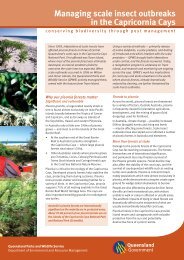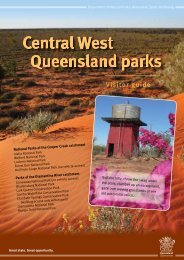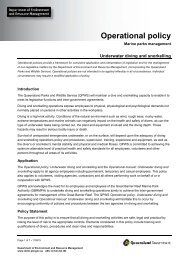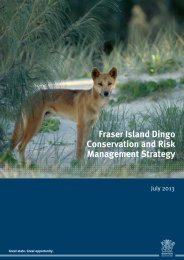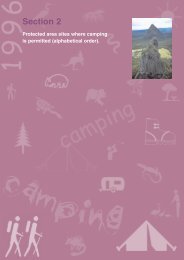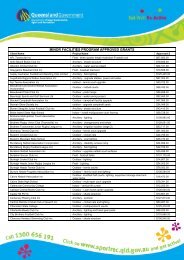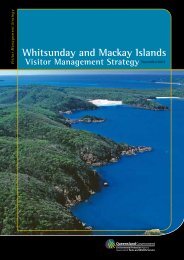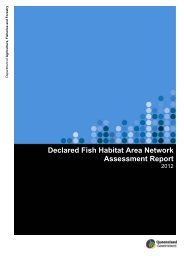Head - Department of National Parks, Recreation, Sport and Racing
Head - Department of National Parks, Recreation, Sport and Racing
Head - Department of National Parks, Recreation, Sport and Racing
You also want an ePaper? Increase the reach of your titles
YUMPU automatically turns print PDFs into web optimized ePapers that Google loves.
which are more likely to succeed <strong>and</strong> which are likely to assist<br />
in realising the visions for the regions. Investment opportunity<br />
criteria have been applied to each project. The plan has been<br />
prepared being cognisant <strong>of</strong>, <strong>and</strong> having regard to, the tourism<br />
objective outlined in the Wide Bay Burnett Regional Plan 2007-<br />
2026 (WBBRP). 4<br />
This TOP is not however, a summary <strong>of</strong> all projects, all plans<br />
<strong>and</strong> strategies. It provides a vision for tourism in the Bundaberg<br />
<strong>and</strong> Fraser Coast regions <strong>and</strong> thus is selective. The focus for<br />
this TOP has been on tourism development <strong>and</strong> investment to<br />
particularly attract more intrastate <strong>and</strong> interstate visitors <strong>and</strong> to<br />
identify opportunities that will encourage these visitors to stay<br />
longer <strong>and</strong> spend more. For the proposed projects to progress<br />
further it will be necessary in most instances to undertake a<br />
more detailed assessment <strong>of</strong> their potential viability through<br />
feasibility studies. These studies will need to address project<br />
benefits, costs, impacts, scope <strong>and</strong> resourcing.<br />
This TOP must also be viewed within the context <strong>of</strong> overarching<br />
regional planning strategies <strong>and</strong> policies. These include, but are<br />
not limited to:<br />
� The review <strong>of</strong> residential supply <strong>and</strong> alternative patterns <strong>of</strong><br />
development which will inform a preferred pattern <strong>of</strong> urban<br />
development <strong>and</strong> associated urban footprints for the region;<br />
� Identification <strong>of</strong> the location <strong>and</strong> capacity <strong>of</strong> current <strong>and</strong><br />
future regionally significant infrastructure via an audit by the<br />
<strong>Department</strong> <strong>of</strong> Infrastructure <strong>and</strong> Planning to support the<br />
Wide Bay Burnett Region Plan 2007 – 2026;<br />
� The Wide Bay Burnett Environmental <strong>and</strong> Assets Strategy to<br />
identify <strong>and</strong> evaluate regionally significant environmental <strong>and</strong><br />
natural assets;<br />
� The Wide Bay Burnett <strong>Recreation</strong> <strong>and</strong> <strong>Sport</strong>s Strategy<br />
which will identify hard infrastructure <strong>and</strong> open space<br />
opportunities;<br />
� The Wide Bay Burnett Regional Water Supply Strategy to<br />
secure the region's water supplies for the next 50 years;<br />
� The Wide Bay Burnett Industrial L<strong>and</strong> Dem<strong>and</strong> Strategy to<br />
assess dem<strong>and</strong> <strong>and</strong> identify suitable sites; <strong>and</strong><br />
� An aged care strategy for the region.<br />
Potential challenges for the two regions include improved<br />
co-ordination <strong>of</strong> tourism between different areas in the two<br />
regions, for example matching mature tourism br<strong>and</strong>s such as<br />
Fraser Isl<strong>and</strong> with lesser known br<strong>and</strong>s like The Hinkler Hall <strong>of</strong><br />
Aviation <strong>and</strong> identifying product gaps such as between<br />
accommodation <strong>and</strong> other tourism product (especially in the<br />
hinterl<strong>and</strong>s) for example not enough accommodation in<br />
Bundaberg <strong>and</strong> not enough built tourism attractions in<br />
Hervey Bay.<br />
The regions must also be cognisant <strong>of</strong> geographic realities.<br />
Hervey Bay is just 1.5 hours drive north <strong>of</strong> the Sunshine Coast;<br />
which also identifies itself as a “predominantly coastal<br />
destination with a growing hinterl<strong>and</strong>….has a strong focus on<br />
natural attractions including beaches <strong>and</strong> <strong>National</strong> <strong>Parks</strong> <strong>and</strong><br />
provision <strong>of</strong> recreational, outdoor attractions <strong>and</strong> nature based<br />
experiences” 5. Fraser Coast is set apart from this southern area<br />
by a number <strong>of</strong> factors, predominantly the World Heritage Fraser<br />
Isl<strong>and</strong>. Whilst a successful experience, the isl<strong>and</strong> can be further<br />
developed to exp<strong>and</strong> its iconic status <strong>and</strong> further reflect the<br />
“blue” eco-adventure nature <strong>of</strong> the Bundaberg <strong>and</strong> Fraser Coast<br />
area. However, to achieve the potential for repeat visitation, the<br />
entire area must also develop other tourism product.<br />
This plan helps to identify other options for encouraging visitors<br />
to this region instead <strong>of</strong> (or as well as) tourism destinations to<br />
the south <strong>and</strong> north. The TOP draws on strengthening existing,<br />
<strong>and</strong> where appropriate, creating new tourism nodes <strong>and</strong><br />
regional product, which will help extend visitor length <strong>of</strong> stay<br />
<strong>and</strong> expenditure <strong>and</strong> <strong>of</strong>fer greater dispersal throughout the two<br />
regions.<br />
There are a total <strong>of</strong> 16 national parks, marine parks <strong>and</strong> state<br />
forests in the Bundaberg-Fraser Coast area which are a major<br />
component <strong>of</strong> the region’s existing tourist appeal. However,<br />
with the right style <strong>and</strong> types <strong>of</strong> development <strong>and</strong> tours, these<br />
protected areas could play an even more critical role in helping<br />
to realise the region’s vision as an eco-adventure destination,<br />
underpinning sustainable tourism industry growth. However, any<br />
development <strong>and</strong> tour options will need to recognise current<br />
government policies regarding tourism activities in protected<br />
areas <strong>and</strong> progressed in partnership with the <strong>Department</strong> <strong>of</strong><br />
Environment <strong>and</strong> Resource Management (DERM)/Queensl<strong>and</strong><br />
<strong>Parks</strong> <strong>and</strong> Wildlife Service (QPWS).<br />
There are significant opportunities in the hinterl<strong>and</strong> <strong>of</strong> the two<br />
regions, especially from Bundaberg City, to create tourism<br />
product based around the natural l<strong>and</strong>scapes. <strong>Parks</strong> <strong>and</strong><br />
forests are a key asset for growing hinterl<strong>and</strong> tourism <strong>and</strong> it is<br />
vital within this plan’s timeframe that key players from all<br />
relevant agencies come together, recognise the latent<br />
opportunities <strong>and</strong> work towards projects that will deliver on the<br />
research outcomes which show a propensity for greater nature<br />
based <strong>and</strong> wilderness experiences. Whilst visitor numbers to<br />
the majority <strong>of</strong> these national park locations are thought to be<br />
necessarily low, there is opportunity to increase numbers on a<br />
sustainable basis for the future.<br />
The ability to achieve this is dependent upon: improved road<br />
access; exp<strong>and</strong>ed visitor facilities including camping <strong>and</strong> other<br />
accommodation options, shelters, visitor interpretation <strong>and</strong><br />
marked trails <strong>and</strong> walks. The cost <strong>of</strong> creating this infrastructure<br />
is not insubstantial <strong>and</strong> therefore great care is needed to ensure<br />
that cost-effective infrastructure investment is carefully<br />
prioritised where the greatest opportunities for visitor growth are<br />
likely to be forthcoming. As the DERM/QPWS is not currently<br />
resourced to provide all the required infrastructure other<br />
partners may need to be found over time. There is little point in<br />
actively promoting the parks as tourism assets without the<br />
introduction <strong>of</strong> enhanced infrastructure.<br />
The TOP ultimately focuses on those projects which are more<br />
likely to gain stakeholder support <strong>and</strong> which can lead to many<br />
<strong>of</strong> the other projects being developed over time. This has<br />
meant that many projects suggested during the course <strong>of</strong> the<br />
consultation, whilst having recreational value, may not be<br />
sufficiently strong to attract interstate or intrastate visitors. They<br />
are nevertheless very important, but unlikely to stimulate tourist<br />
dem<strong>and</strong> to the local community.<br />
4 “To effectively capitalise on the region’s natural advantages <strong>and</strong> current trends <strong>and</strong> patterns in tourism, in order to promote a sustainable, prosperous tourism industry<br />
through enhancing viability, innovation, efficiency <strong>and</strong> market awareness”, WBBRP, Queensl<strong>and</strong> Government, page 94<br />
5 Sunshine Coast TOP, TQ <strong>and</strong> Tourism Sunshine Coast, 2008 (not yet published), page 2<br />
3<br />
Executive summary




